By Jim Stevenson
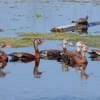 If there is anyone you can think of who might wish to receive these photos, please send me their name and e-mail. Or have them contact me below.
If there is anyone you can think of who might wish to receive these photos, please send me their name and e-mail. Or have them contact me below.
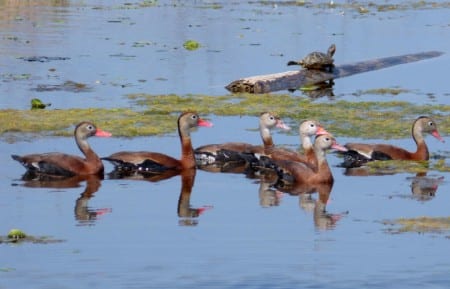
Waterfowl are represented mostly by ducks, especially in the Continent’s lower regions. A group that actually has moved gradually up from the New World Tropics is whistling-ducks. The tawny-brown Fulvous WDs pass by the Upper Texas Coast out over the Gulf on their way to their Louisiana nesting grounds. However these Black-bellied Whistling-ducks stop in our area and many have become permanent residents. They are cavity nesters while the Fulvous nest in the marshes of southern Louisiana.
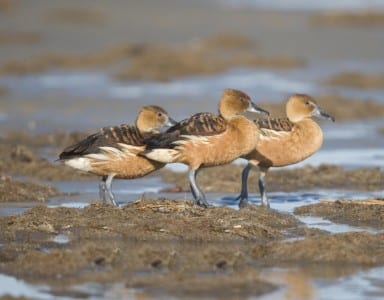
Downed by harsh winds, this trio of Fulvous Whistling-ducks face the wind and hunker down at the end of San Luis Pass. Whistlers have longer legs than North American ducks and they squeal, rather than quack. I feel unfortunately led to share an embarrassing experience. In high school, our football coach was addressing us and remarked that, “If it quacks like a duck…” In a moment of insanity, I blurted out that not all ducks quacked; some squealed. I saw my life pass before my eyes when he walked up (over?) to me and said, “Son, you’re gonna squeal, too.” “Coach” Murray later became a principal, for as we all know, coaching is the perfect preparation for school administration. I better shut up.
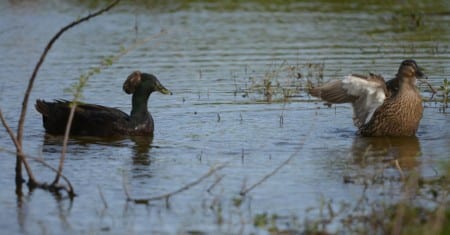
All kinds of weird stuff happen with waterfowl in North America because of the domestication of so many. Here, there is a fairly typical female Mallard on the right (too light for Mottled) hanging out with a Mallard/Muscovy hybrid. Either deformed or injured, he has a huge mass of feathers growing out of the right side of his noggin. Whaddaya think, gals? 😉 Teal are our smallest dabbling ducks and fly nearly 70 mph when chased. These Green-winged are so small they can take off like a rocket, even without slapping their wings on the water. Here you can see that most male ducks have a colorful, often dark head and a rectangular patch of colored feathers on the rear of their secondaries. You can also see the shorter legs on our North American ducks.
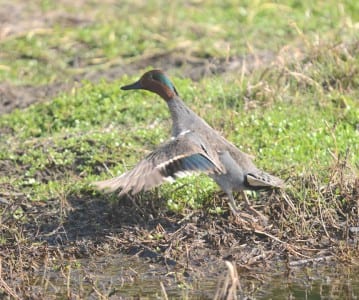
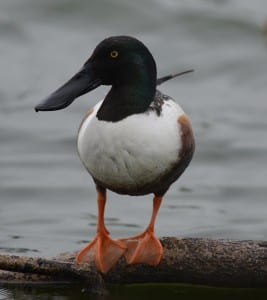
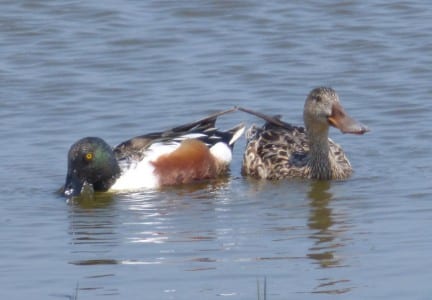
Shovelers are late to pair up owing to the late development of the butt-ugly-in-winter males. This is a late March bird and it looks pretty good (according to the hen beside him). These birds were at the sewage treatment plant near Austin (Hornsby Bend), and with lawmakers there, you can imagine how much, well, never mind.
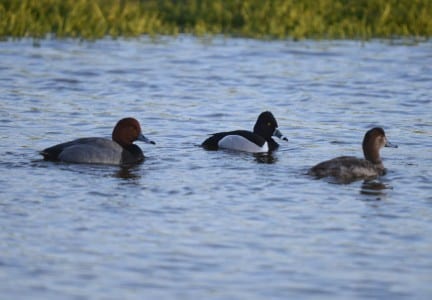
Diving ducks don’t generally have specula (wing patches) and also ride lower in the water, due to being heavier for diving underwater. Redheads (pair on left and right) have been amazingly abundant this winter on the UTC, but unusual on the Island was the Ring-necked Duck in the middle. You can tell he’s a Ring-necked Duck because he has a ring around the, um, bill.
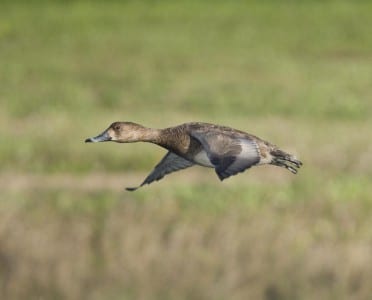
This is the female Redhead airborne, showing off her gray wing-stripes and heavier body than dabblers. Also note the dark nail on the bill, with the melanin stiffening the beak for use gathering mollusks and such. Most diving ducks eat animals (at least, in part) so their meat is not as preferred by hunters as the vegetarian dabblers.
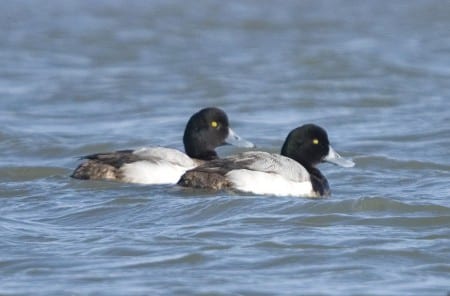
Scaup represent two species (in North America) and these two males demonstrate the subtle difference two birds can show while their plumage develops. The male on the right has a fairly green head but the left duck is not so green, yet. This is probably not age so much as the latitude of their breeding range. Scaup have white wing-stripes while the Redheads and RN Ducks on the previous page have gray wing-stripes. An uncommon bird in our parts, these are Greater Scaups, as opposed to the more common Lessers. The green head would be a tip-off, but the fully rounded head is a more reliable trait. If flushed, you’d like see a much longer white wing-stripe in these Greaters.
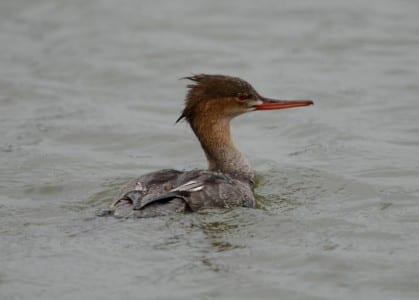
Mergansers are our only fish-eating ducks, diving underwater and catching them with their long, serrate bills. The common species in the Deep South is the Red-breasted Merganser, generally found more in the marine realm than fresh water. They are fairly easily separated from the more northern Commons by the punk hair (feathers).
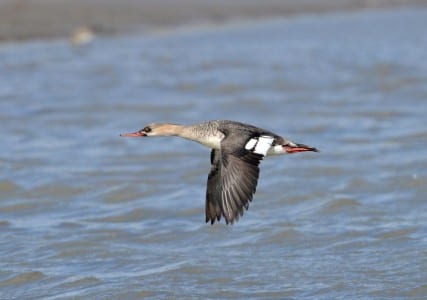
This bird appears at first to be another brown hen but the tell tale green of the male is just beginning to form on the head. Mergansers are fairly heavy, elongate ducks with large wings to carry them through the air. Like almost all ducks, they are winter residents in the Deep South. The primaries and secondaries are clearly defined in this shot.
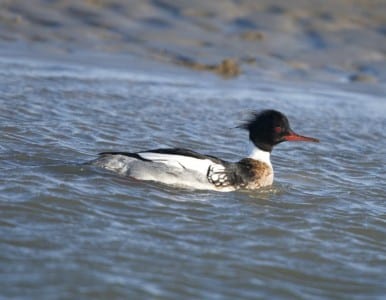
Full males are quite showy ducks, with a shaggy, green head and bold, black-and-white patterns atop. The red eyes are for viewing underwater, but you gotta admit, it matches the bill really well. As diving ducks, mergansers must paddle across the water in order to get airborne quickly. These birds are not hunted, as their flesh is gamey, due to their piscine diet.
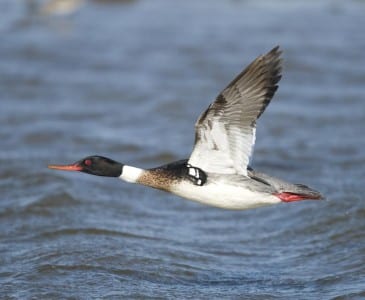
It’s interesting to me that so many male ducks have green heads (Mallards, shovelers, goldeneye, two mergansers, etc.). Still, there are some purples, reds and other colors out there as well. These probably serve a duel purpose for courtship as well as ruptive marks, as the dark colors break up the form of the bird while at rest. Oh, note how the crest lays down when the bird is in flight.
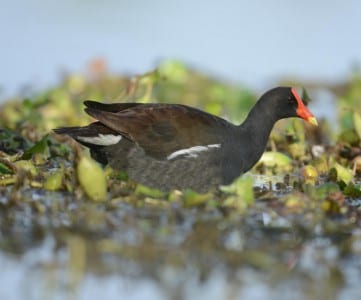
Some rails swim and this recently renamed Common Moorhen is one example. They aren’t ducks, of course, and their vertical bill is a quick tipoff. Moorhens and coots also have the frontal shield not found in ducks, and their feet are not fully webbed, either. And is it me, or does that bill remind me of candy corn?
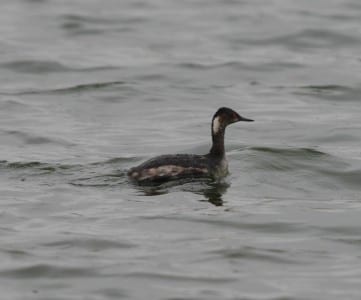
Grebes are also not ducks and their bills are a good field mark. This is the Eared Grebe that winters in this part of Texas, especially on the Texas City Dike (sometimes in Offat’s Bayou). This is basically the western counterpart ofthe Horned Grebe, and this bird has a skinnier, more erect neck. The winter-plumaged Horned Grebes back East also have a whiter throat.

 Posted in
Posted in 























